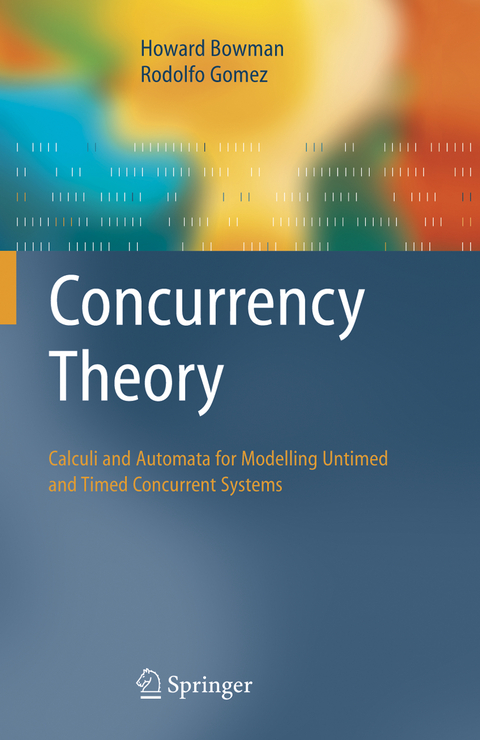
Concurrency Theory
Calculi an Automata for Modelling Untimed and Timed Concurrent Systems
Seiten
2010
|
Softcover reprint of hardcover 1st ed. 2006
Springer London Ltd (Verlag)
978-1-84996-951-2 (ISBN)
Springer London Ltd (Verlag)
978-1-84996-951-2 (ISBN)
The simple reason is that it is easier for us to think about sequential, rather than concurrent, systems. Over a period of 25 years, or so, the ?eld of concurrency theory has been involved in the development of a set of mathematical techniques that can help system developers to think about and build concurrent systems.
Intheworldweliveinconcurrencyisthenorm.Forexample,thehumanbody isamassivelyconcurrentsystem,comprisingahugenumberofcells,allsim- taneously evolving and independently engaging in their individual biological processing.Inaddition,inthebiologicalworld,trulysequentialsystemsrarely arise. However, they are more common when manmade artefacts are cons- ered. In particular, computer systems are often developed from a sequential perspective. Why is this? The simple reason is that it is easier for us to think about sequential, rather than concurrent, systems. Thus, we use sequentiality as a device to simplify the design process. However, the need for increasingly powerful, ?exible and usable computer systems mitigates against simplifying sequentiality assumptions. A good - ample of this is the all-powerful position held by the Internet, which is highly concurrent at many di?erent levels of decomposition. Thus, the modern c- puter scientist (and indeed the modern scientist in general) is forced to think aboutconcurrentsystemsandthesubtleandintricatebehaviourthatemerges from the interaction of simultaneously evolving components. Over a period of 25 years, or so, the ?eld of concurrency theory has been involved in the development of a set of mathematical techniques that can help system developers to think about and build concurrent systems. These theories are the subject matter of this book.
Intheworldweliveinconcurrencyisthenorm.Forexample,thehumanbody isamassivelyconcurrentsystem,comprisingahugenumberofcells,allsim- taneously evolving and independently engaging in their individual biological processing.Inaddition,inthebiologicalworld,trulysequentialsystemsrarely arise. However, they are more common when manmade artefacts are cons- ered. In particular, computer systems are often developed from a sequential perspective. Why is this? The simple reason is that it is easier for us to think about sequential, rather than concurrent, systems. Thus, we use sequentiality as a device to simplify the design process. However, the need for increasingly powerful, ?exible and usable computer systems mitigates against simplifying sequentiality assumptions. A good - ample of this is the all-powerful position held by the Internet, which is highly concurrent at many di?erent levels of decomposition. Thus, the modern c- puter scientist (and indeed the modern scientist in general) is forced to think aboutconcurrentsystemsandthesubtleandintricatebehaviourthatemerges from the interaction of simultaneously evolving components. Over a period of 25 years, or so, the ?eld of concurrency theory has been involved in the development of a set of mathematical techniques that can help system developers to think about and build concurrent systems. These theories are the subject matter of this book.
Background on Concurrency Theory.- Concurrency Theory — Untimed Models.- Process Calculi: LOTOS.- Basic Interleaved Semantic Models.- True Concurrency Models: Event Structures.- Testing Theory and the Linear Time — Branching Time Spectrum.- Concurrency Theory — Further Untimed Notations.- Beyond pbLOTOS.- Comparison of LOTOS with CCS and CSP.- Communicating Automata.- Concurrency Theory — Timed Models.- Timed Process Calculi, a LOTOS Perspective.- Semantic Models for tLOTOS.- Timed Communicating Automata.- Timelocks in Timed Automata.- Discrete Timed Automata.
| Zusatzinfo | 126 Illustrations, black and white; XX, 422 p. 126 illus. |
|---|---|
| Verlagsort | England |
| Sprache | englisch |
| Maße | 155 x 235 mm |
| Themenwelt | Mathematik / Informatik ► Informatik ► Software Entwicklung |
| Informatik ► Theorie / Studium ► Algorithmen | |
| ISBN-10 | 1-84996-951-5 / 1849969515 |
| ISBN-13 | 978-1-84996-951-2 / 9781849969512 |
| Zustand | Neuware |
| Haben Sie eine Frage zum Produkt? |
Mehr entdecken
aus dem Bereich
aus dem Bereich
Buch | Softcover (2024)
Lehmanns Media (Verlag)
39,99 €
IT zum Anfassen für alle von 9 bis 99 – vom Navi bis Social Media
Buch | Softcover (2021)
Springer (Verlag)
29,99 €
Interlingua zur Gewährleistung semantischer Interoperabilität in der …
Buch | Softcover (2023)
Springer Fachmedien (Verlag)
32,99 €


